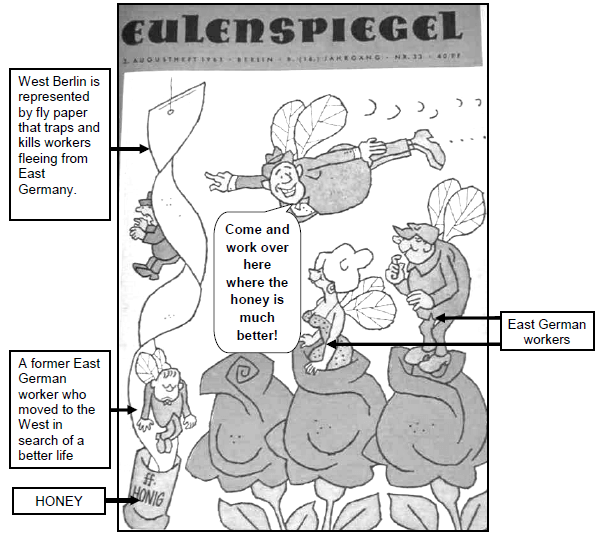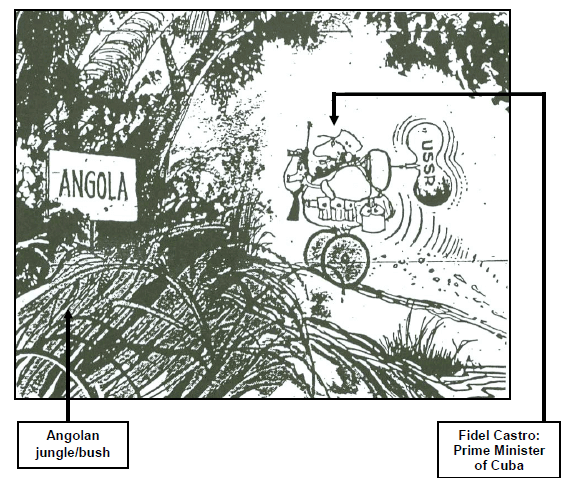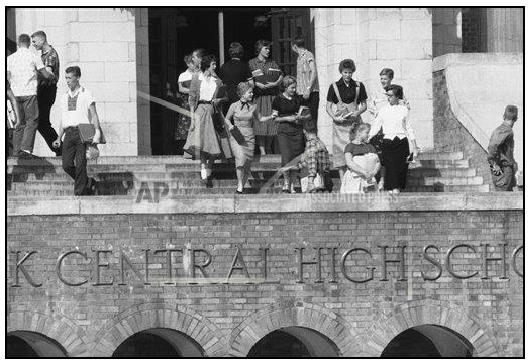HISTORY PAPER 1 GRADE 12 ADDENDUM - NSC PAST PAPERS AND MEMOS FEBRUARY/MARCH 2016
Share via Whatsapp Join our WhatsApp Group Join our Telegram GroupHISTORY P1
FEBRUARY/MARCH 2016
ADDENDUM
NATIONAL SENIOR CERTIFICATE
GRADE 12
QUESTION 1: WHY DID THE GERMAN DEMOCRATIC REPUBLIC DECIDE TO BUILD THE BERLIN WALL IN 1961?
SOURCE 1A
The following source, entitled 'What you should know about the Wall', is taken from a brochure that was published in 1962. It was produced by the East German government and gives the reasons for building the Berlin Wall. It was published in English and was intended for foreign distribution.
[The Wall] was the result of developments of many years' standing in West Germany and West Berlin. Let us recall preceding events: In 1948, a separate currency reform was introduced in West Germany and West Berlin. The West German reactionaries (backward-looking) thereby split Germany and even Berlin into two currency areas. The West German separatist state was founded in 1949. Bonn (the capital city of West Germany) thereby turned the zonal border into a state frontier. In 1954 West Germany was included in NATO (the North Atlantic Treaty Organisation). The decision on the atomic armament of the West German Bundeswehr (German army) was made in 1958. Thus, Bonn continued to aggravate the situation in Germany and Berlin ... We have submitted more than one hundred proposals for an understanding on the renunciation (giving up) of atomic armament and on the withdrawal of the two German states from NATO or the Warsaw Treaty. If things had gone according to our proposals the situation in Germany would not have been aggravated (made worse) and, consequently, there would have been no wall ... We no longer wanted to stand by passively and see how doctors, engineers and skilled workers were induced (encouraged) ... to give up their secure existence in the GDR (German Democratic Republic) to work in West Germany or West Berlin. These and other manipulations cost the GDR annual losses amounting to 3,5 billion marks. But we prevented something much more important with the wall: West Berlin's becoming the starting point for military conflict. |
SOURCE 1B
This source was written by DF Fleming, an American historian, in 1961. It describes the economic prosperity and political freedom that was evident in West Berlin. It outlines the reasons for the construction of the Berlin Wall.
By 1961, West Berlin was a glittering outpost of capitalism, luxurious (rich) by comparison to East Berlin, prosperous (successful), bustling (busy). The United States had poured $600 million into West Berlin. West Germany had also contributed heavily to making it a shining example of our way of life ... The economic comparison was damaging enough, but the comparison between individual liberties in West Berlin and the regimented, tight police controls around it was still worse. The contrast led 300 000 East Germans each year to disappear into West Berlin and be flown out to West Germany. Mostly they were young, talented, educated and professional people, a drain which could not be endured indefinitely (forever) ... Since 1949, 3 million people had gone through the escape hatch (exit) and the population was declining. West Berlin also contained the greatest combination of espionage (spy or secret service) agencies ever assembled in one place. It was an almost unbelievable windfall (for the West) to be able to pursue missions of modern 'intelligence', including sabotage (damage), 110 miles (200 kilometres) deep in 'the enemy's territory'. Western radio stations and all other propaganda arms had the same advantage. For all these reasons West Berlin was like a deep running sore (a dangerous wound) to the East. |
SOURCE 1C
This cartoon was published in an East German magazine, Eulenspiegel, in 1961, before the Berlin Wall was built. It shows an East German worker flying to West Berlin in search of a better life. The message in the speech bubble has been translated and re-typed for clarity.
SOURCE 1D
This extract focuses on the short-term reasons for East Germany's decision to build the Berlin Wall.
... The forced collectivisation policy (a policy of taking private land into state ownership) in East Germany was disastrous (terrible) and there was consequently a massive rise in the number of refugees fleeing westwards through the open frontier in Berlin. In 1960, 199 000 fled and in the six months up to June 1961 a further 103 000. By June 1961 reports were pouring into government offices from the Stasi (the East German secret police) of unrest and discontent in the factories … The torrent (flood) of refugees this policy caused made the closure of the frontier in Berlin inevitable if the GDR was not to collapse. Ulbricht (the East German leader) finally achieved the go-ahead for this at the meeting of the Warsaw Pact states (the USSR and its allies in Eastern Europe) on 3 to 5 August 1961. The operation was well planned by Honecker, the minister in charge of security, and was carried out in the early hours of 13 August. Initially, the 'anti-fascist protective wall' (the name given to the Berlin Wall by East German authorities) consisted mainly of barbed wire, but this was rapidly replaced by a more permanent concrete structure. |
QUESTION 2: WHY DID SOUTH AFRICA AND CUBA BECOME INVOLVED IN THE COLD WAR IN ANGOLA AFTER 1975?
SOURCE 2A
This source focuses on a speech that was delivered by the South African Prime Minister, BJ Vorster, in the House of Assembly in 1976. Vorster outlined the reasons for South Africa's intervention in the Cold War in Angola.
In the House of Assembly in January 1976 Vorster (South Africa's Prime Minister) placed the blame for South Africa's intervention in Angola squarely on the shoulders of the Russians and Cubans: 'Our involvement was the effect of Russian and Cuban intervention. If they did not enter Angola, if they did not take part in this affair, if they did not try to subvert (undermine) the whole of Angola and to suppress (contain) its people, South Africa would never have entered Angola at all ... We went in to chase Cuba and the MPLA away from the dams (Ruacana and Calueque).' It can hardly be doubted that the support which the Russians and the Cubans gave to the MPLA in the form of arms and training contributed in some measure to motivating South Africa's intervention, but it is unlikely that it was as crucial a reason as Vorster implied. It was Swapo, not the Cubans and the MPLA, who threatened the two dams between Ruacana and Calueque. The main reason for South Africa's intervention in Angola was not the presence of Russians and Cubans, but the desire (longing) to prevent a hostile MPLA government from taking control. When South African troops began to invade Angola early in October, there were hardly any Russians and very few Cubans in the country. There is also evidence that President Kaunda of Zambia and President Mobutu of Zaire, neither of whom favoured the MPLA, welcomed South Africa's support for the FNLA and UNITA. ... South Africa's actions drew her progressively (more and more) deeper into the Angolan war ... General Hendrik van den Bergh was sent to France to purchase weapons to the value of R20 million for the FNLA and UNITA ... South African instructors began to train FNLA and UNITA soldiers in southern Angola. |
SOURCE 2B
The following cartoon by Thomas Wright, an American artist, appeared in the Miami News. It was reprinted in the Washington Post on 7 December 1975. The cartoon depicts the involvement of the USSR and Cuba in Angola during the first phase of the Angolan Cold War, which was fought from 1975 to 1976.
SOURCE 2C
This source focuses on an interview between the South African Prime Minister, BJ Vorster, and an American journalist, Arnaud de Borchgrave. The interview was about South Africa's decision to intervene in the Cold War in Angola. It was published in Newsweek on 17 May 1976.
South Africa, waiting for the Cubans to roll southwards into the vacuum that its withdrawal had left, was bitter about the failure of the West and secret black African allies to give open support. Pieter Botha (South Africa's defence minister), John Vorster and 'high officials' in Cape Town began to tell senior South African journalists that South Africa had intervened in Angola at the urging (insistence) of the United States and certain black African countries, particularly Zambia and Zaire ... And an interview at the time between Vorster and senior Newsweek journalist, Arnaud de Borchgrave, went like this: De Borchgrave: Would it be accurate to say that the US solicited (requested) South Africa's help to turn the tide against Russians and Cubans in Angola during last fall (autumn)? Vorster: I do not want to comment on that. The US government can speak for itself. I am sure you will appreciate that I cannot violate (go against) the confidentiality of government-to-government communications. But if you are making the statement, I won't deny it. De Borchgrave: Would it also be accurate to say that you received the green light from Kissinger for a military operation in Angola and that at least six moderate black African presidents had given you their blessing for the same operation? Vorster: If you say that of your own accord, I will not call you a liar. |
SOURCE 2D
This is an extract from a speech delivered by Fidel Castro on 19 April 1976. It focuses on the reasons for Cuba's involvement in the Cold War in Angola.
Instigated (started) by the United States, regular troops from Zaire entered Angolan territory in the summer of that same year (1975), while South African military forces occupied the Cunene area in the month of August and sent arms and instructors to UNITA bands. At that time there wasn't a single Cuban instructor in Angola. The first material aid and the first Cuban instructors reached Angola at the beginning of October, at the request of the MPLA, when Angola was openly invaded by foreign forces. However, no Cuban military unit was sent to Angola to participate directly in the fight, nor was that projected. On 23 October 1975, also instigated (started) by the United States, South African regular army troops, supported by tanks and artillery, invaded Angolan territory across the Namibian border and penetrated deeply into the country, advancing between sixty and seventy kilometres a day. On 3 November they had penetrated more than five hundred kilometres into Angola ... On 5 November 1975, at the request of the MPLA, the leadership of our party decided to send with great urgency a battalion of regular troops with antitank weapons to help the Angolan patriots (loyalists) resist the invasion of the South African racists. This was the first Cuban troop unit sent to Angola. |
QUESTION 3: HOW DID AMERICANS REACT TO THE INTEGRATION OF CENTRAL HIGH SCHOOL IN LITTLE ROCK, ARKANSAS, IN 1957?
SOURCE 3A
This source appeared in a bulletin that was issued by the principal of Central High School on 25 September 1957. It was titled 'What Should Students Do' and provided guidelines on how students should conduct themselves at school during the process of school integration.
This is the second bulletin to read without discussions in your home room. Last night the Federal Court ordered the Board of Education to begin today the integration of white and Negro* (African-American) pupils at this high school level, according to the plan of limited integration approved by the court and sustained on appeal. This Federal Court-approved plan recognised the responsibility of the Board of Education to preserve the high quality of education in our schools. In order to carry out the directions of the Court, a group of qualified Negro pupils have been enrolled in Central High School this year. These students may be in attendance today, or at any future time. As a student of Central High School you have certain duties to yourself, and your community. You should know your responsibilities.
You have a responsibility to your school: Central High School has a reputation as one of the leading public high schools of the nation. It is important to each of us to keep it in that position. We can do that if each pupil and teacher will go quietly about our business here at school – learning and teaching. There must be no 'incidents' at school. Jess W Matthews, Principal |
*Negro: A derogatory (offensive) term used to refer to African-Americans
SOURCE 3B
This photograph shows part of a group of about 60 to 75 white American students who marched out of Central High School on 3 October 1957. They were against the process of school integration.
SOURCE 3C
This is an extract from an article entitled 'Fear is Portable' by Terrence J Roberts, who was one of the Little Rock Nine. It focuses on his experiences in the Mathematics (Algebra) class at Central High School in 1957.
Algebra class was a haven for me. The teacher, Mrs Helen Conrad, let it be known from the first day that she would not tolerate no nonsense from anyone who opposed my presence. She was emphatic (forceful) about it and the class responded accordingly. It was at this class also that I met Robin Woods, a white student who shared her textbook with me. Since my books and other school supplies were routinely destroyed by fellow students, I would come to class often with no supplies. Robin simply pulled her desk next to mine and we shared her book, an act that did not win her friends or favour. Her act of kindness was interpreted as a violation of the social code that outlawed any contact between black students and white students, especially black males and white females. Robin did not allow that kind of thinking to interfere with her choices. |
*Nigger: A derogatory (offensive) term used to refer to African-Americans
SOURCE 3D
This is an account by Ernest Green (one of the Little Rock Nine). He outlines his experiences at the graduation ceremony that was held at Central High School in 1958. Green was the first African-American student to graduate from Central High School.
Graduation was the end of May. I had been there nine months and had thought that all I needed to do was to graduate, just get out of there, so that it would be impossible for white people to say that nobody black had ever graduated from Central High School ... At the graduation ceremony, one of the guests was Martin Luther King. He was speaking in Pine Bluff, Arkansas, at the black college there. And he came up to sit with my mother and Mrs Bates and a couple of other friends in the audience. I figured all I had to do was walk across that big huge stage, which looked the length of a football field. I kept telling myself I just can't trip, with all those cameras watching me. But I knew that once I got as far as that principal and received that diploma, that I had cracked the wall. There were a lot of claps for the students. They talked about who had received scholarships, who was an honor student, and all that as they called their names off. When they called my name there was nothing, just the name, and there was this eerie (strange) silence. Nobody clapped. But I figured they didn't have to. Because after I got that diploma, that was it. I had accomplished what I had come for. |
ACKNOWLEDGEMENTS
Visual sources and other historical evidence were taken from the following:
Bridgland, F (1987). Jonas Savimbi – A Key to Africa (Paragon House, New York)
Facing History and Ourselves Teaching Guide (Facing History and Ourselves National Foundation, Inc.)
Fleming, DF (1961). The Cold War and its Origins (Doubleday, Garden City, New York)
Gleijeses, P (2003). Conflicting Missions – Havana, Washington, Pretoria (Galago, Alberton)
Hampton, H and Fayer, S (1990). Voices of Freedom – An Oral History of the Civil Rights Movement from the 1950s through the 1980s (Bantam, New York)
http://www.apimages.com/metadata/Index/Watchf-AP-A-AR-USA-APHS138229-African-American-/894c1234054f4e4eaf3227726557cf07/6/1
http://research.calvin.edu/german-propaganda-archive/schlugs13.htm
http://research.calvin.edu/german-propaganda-archive/eule61.htm
http://www.santacruzsentinel.com/ci_18674221
Liebenberg, BJ and Spies, SB (eds.) (1999). South Africa in the 20th Century (JL van Schaik, Pretoria)
Waters, M (ed.) (2013). Cuba & Angola – Fighting for Africa's Freedom and Our Own (Pathfinder Press, New York)
Williamson, D (2001). Germany from Defeat to Partition 1945–1963 (Pearson Education Limited, Harlow)